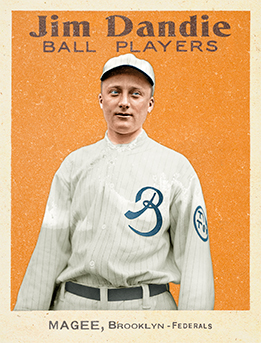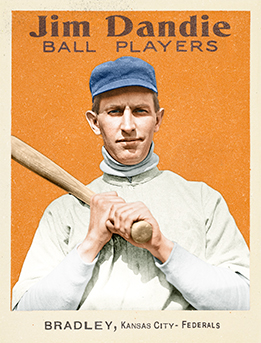
- Series: Jim Dandie Feds
- City: Brooklyn
- Team: Tip-Tops
- League: Federal League
Leo Christopher Magee (1889-1966) started his major league career in dramatic fashion as he and his Cardinal teammates helped rescue dozens of fellow passengers when their train wrecked in Connecticut. His manager Roger Bresnahan liked what he saw despite Magee's weak hitting, putting him in for the injured Miller Huggins at second and then moving him to left where he acquired the nickname “Flash.” Magee finished that 1911 season with a much improved batting average--.290--good for third on the team. Leo was a hothead, encountering numerous run-ins with umpires, squabbling with management over salary and even getting ejected mid-game for fighting—with teammate Ted Cather. Nevertheless, or perhaps because of his fiery style, John McGraw chose Magee as a member of a world-tour exhibition competing with Charles Comiskey's American Leaguers. He showed his flair for the dramatic could work on the field in a match in Medford, OR, when in pouring rain, he glided toward the line in left to make a grab while carrying an umbrella. The teams ended their circumnavigation of the globe aboard the Lusitania after their last games in England in March 1914. He was courted by the new Federal League Chicagos but remained with Mordecai Brown's Terriers for a fine season before finally jumping to the Brooklyn Tri-Tops in '15 where he also became, at 25, one of the youngest managers. He wasted no time demonstrating his temper, getting ejected in the first inning of the home opener. The experiment of trying such a youngster in the pilot's role failed as Lee's tough style alienated his veteran players and fans alike. His skill at bat and afield caused old mate Huggins, now managing the Yankees, to bring Magee aboard for the 1916 season. Huggins termed Lee “the prize of the Federal League collection.” Salary disputes, unsavory associations and union activity all combined to cast a long shadow over Magee's latter years. Finally, in 1919, he was ousted from the game with Hal Chase for allegations of throwing a game.
- Despite a fine career average of .276 in nine seasons, Magee's tenure ended ignominiously due to a jury verdict that proved the precursor to MLB's crusade against gambling which culminated the next year in the Black Sox affair

- Series: Jim Dandie Feds
- City: Indianapolis
- Team: Hoosiers (FL)
- League: Federal League
James Joseph Esmond (1889-1948) played shortstop for three major league clubs from 1911-1915, half of his tenure being with two Federal League teams: the Indianapolis Hoosiers and Newark Pepper. Jimmy had started in pro ball with the Gloversville-Johnstown/Elmira nine of the New York State League in 1908, a team with constituents all over the upstate area that would be reconstituted from 1939-51 in the Canadian-American League. Esmond never managed much offensive output in the minors and may have been that rare player to perform better when he got to the Cincinnati Reds in 1911 and hit .273. He reverted to form in '12, taking a demotion to the International League's Montreal team in 1913 before getting a final chance at major league glory in the renegade Federal League. He would be out of baseball for all of his late twenties before reappearing with Syracuse of the IL in 1921 at age 31. He then moved to the Eastern League and played a season each for Waterbury, Albany and Pittsfield. Jimmy's performance in Indiana and New Jersey far exceeded his norm, undoubtedly due to the paucity of truly major league caliber talent as the Feds tried valiantly to compete as a third league. He hit .295 for the Hoosiers with a league-leading 15 triples. Though his batting average subsided with the Peps he hit 11 more three-baggers showing extra-base prowess heretofore not in evidence. Esmond's debut in Newark allowed him to bask in the glow described in the local paper: “Newark and its surrounding hamlets were seized with a violent attack of baseball yesterday, accompanied by a high fever and laryngitis. The ailment can be directly traced to the opening of the Newark Federals at their new, roomy park in Harrison. The epidemic spread among nearly 25,000 Jersey folk who jammed the new park to see 'Whoa Bill' Phillip's 'Peps' make their home debut against Otto Knabe's Baltimore Terrapins.” The celebration was dampened a bit by the Terps' 6-2 victory. Sadly, Jimmy's three errors made it tough for starter Cy Falkenberg.
- Esmond's major league debut in Cincinnati was in the ballpark known as the Palace of the Fans, occupied by the franchise since 1902. In 1912 Jimmy and the Reds got to inaugurate Crosley Field, the team's home until 1970

- Series: Jim Dandie Feds
- City: Kansas City
- Team: Packers
- League: Federal League
William Joseph Bradley (1878-1954) played third base better than anyone in the new American League until he was slowed by injury in 1906. Having jumped to the junior circuit from the Chicago Orphans in 1901, Bradley set batting and fielding marks for his hometown Cleveland Blues that would only be eclipsed by the likes of Ty Cobb and Home Run Baker. His pinnacle year came in 1902 when he batted .340, scored 104 runs with 39 doubles and 11 home runs, all putting him in the top five or six in the league. Bradley's output declined markedly following his injury-shortened season in '06. He stayed with Cleveland through the 1910 campaign, still playing regularly but seeing a great drop-off at the plate. He went to the International League's Maple Leafs as player-manager in 1911 but returned to the majors as manager for the Brooklyn Tip-Tops in the new Federal League where he put himself in as an occasional pinch hitter.The team's 77-77 record was good for a fifth-place finish. The next, and last, year for the Federal League saw him with the Kansas City Packers where Bill returned to a back-up role at third, playing in about half the club's games. Though known for his excellent fielding, Bradley figured uncharacteristically in a Cleveland no-hitter in 1908. Bob Rhoads hurled the gem but was shocked when he learned the hit he thought he'd surrendered on a grounder to Bradley had been ruled a rare error. His dazzling play at his position was a throwback to the earlier no-glove era as he mastered a bare-handed scoop-and-toss to throw out attempted bunters, per Stephen Constantelos of SABR. His rival as the best third-sacker of that decade, Jimmy Collins of Boston, told an admiring fan: “Well, if I could field and bat like Bradley, I should lay claim to that title myself.”
- On September 24, 1903 Bradley hit for the cycle in D.C. with 12 total bases
- Bradley's physical issues in 1906 had been presaged by a mysterious illness in '05 when his average began to drop. An intentional inside pitch from NY's Bill Hogg broke Bill's wrist, the first of a series of injuries that would plague him for the rest of his MLB tenure
- Hogg removed any doubt about his intention to disable Bradley when he vowed “The big Frenchman (Nap Lajoie) is next on my list.”

- Series: Jim Dandie Feds
- City: St. Louis
- Team: Terriers
- League: Federal League
John Thomas Tobin (1892-1969) built a fine major league career in the outfield for four teams, primarily in his hometown of St. Louis with the Federal League's Terriers in that organization's two years competing with the AL and NL, 1914-15; then staying on with the Browns for nine campaigns. “Johnny” did himself proud with the Browns, compiling a .318 average. Over his tenure in the big leagues, his average was an excellent .309. Tobin's introduction to the big leagues came via his play for his employer, Bell Telephone. He was literally recruited by the Terriers from atop a pole. He quickly established himself in St. Louis as a popular guy, both with fans and writers. Johnny led his team of MLB castoffs from last in '14 to within an eyelash of the Federal League pennant in '15, earning him a spot on the Browns. Business Manager Branch Rickey thought Tobin needed some seasoning and shipped him to the Salt Lake City Bees for most of 1917, a move that bore the mark of Rickey's genius as Tobin tore up the Coast League, leading the circuit with 265 hits. He would go on to earn the plaudits of no less than teammate George Sisler who termed him “One of the best leadoff men I ever saw” and “the best drag-bunter anyone ever saw.” The crafty speedster began piling up great seasons in St. Louis. He hit .322 in '22 when the club fell just shy of the Yankees, the only team they couldn't beat. Eventually Tobin's speed faded a bit and he was traded to the Senators in 1926 where he played very little before moving on that season to the Red Sox. His finale in '27 was a fitting resurgence by a great hitter as Tobin hit .310 in 111 games.
- Walter Johnson was another fan: “Tobin is a batter of the old school, not unlike Willie Keeler in many respects. I am glad there are not more like him.”
- Johnny became a fixture in his hometown's baseball circles, coaching youth and semi-pro leagues. In 1958 the Baseball Writers Association of America named him to the St. Louis “All-Time All-Star” squad along with such luminaries as Musial, Sisler, Frisch, Hornsby and Dizzy Dean

- Series: Jim Dandie Feds
- City: Pittsburgh
- Team: Rebels
- League: Federal League
Michael William Menosky (1894-1983) earned the nickname “Leaping Mike” for his abilities in the outfield and had some fine years at the plate, particularly for the Red Sox, in his nine-year tenure in the majors. He got his chance with the Pittsburgh Rebels of the Federal League in 1914. The team was aptly named, being one of the “outlaw” clubs that vied with the two established circuits for two years. The Rebels had come into the league as the Stogies, the old Union Association team in the Steel City. In its 1912 incarnation, the club was known as the Filipinos, reflecting not a heretofore unknown Asian connection to baseball, but in honor of its manager Deacon Phillippe. Ah, the romance of the early game! Menosky put up very average numbers in Pittsburgh and then with the Senators, a stint interrupted in 1918 by the war in Europe. He came into his own with Boston where he finished his career from 1920-23. His first three years in Fenway saw Mike bat .297/.300/.283 playing as a regular. His final campaign saw a marked drop-off in offense as he slumped to .229 in only 84 games. These seasons in Beantown pumped up his lifetime batting average to a solid .278. Menosky had speed, witnessed by his 10 triples and 22 steals for Washington in 1917 and the 23 stolen bases for Boston in 1920 that ranked fourth in the AL. He was the Sox' regular left fielder his first two seasons and opened in center in 1922, but only played four games there. Boston released the veteran after the '23 season and Mike went west to play for the PCL's Vernon (southeast Los Angeles) team.
- Menosky became a probation officer after leaving baseball. He played an interesting “expert witness” role in a criminal case involving a defendant charged with hurling a rock through a Detroit railroad terminal window. When the judge was skeptical that the man had the arm for that misdeed, he called Mike to demonstrate what a major league outfielder could do. When Menosky failed to throw the missile the 250 feet required to reach the window, the judge dismissed the case, reasoning that if Mike couldn't do it, the poor suspect couldn't have either




